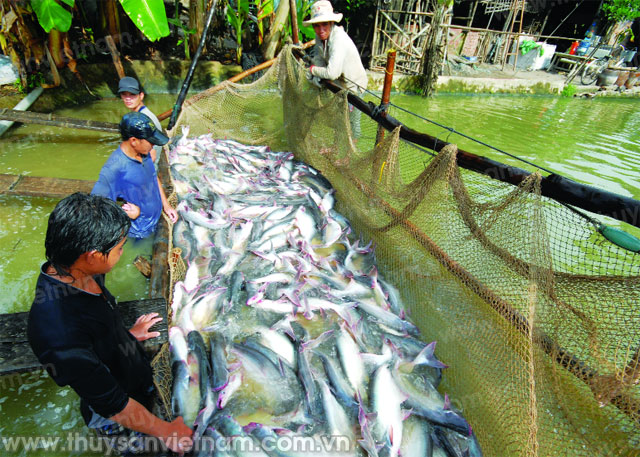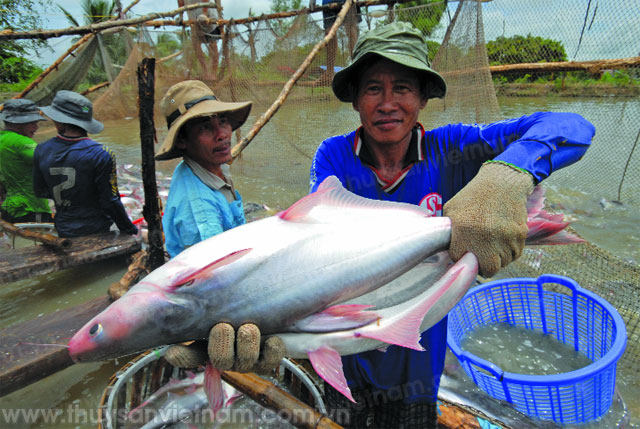In the whole of the Tra fish product chain, which was built for crisis overcoming, incubation is the first stage and plays the most important role. As the quality of Tra fish material will decide the quality of the whole chain, no faults in this stage can be corrected later. Decree 36 stipulates the aquaculture planning as the first priority.
Failing to follow the plan
Dong Thap Province has the largest Tra fish farming area in the Mekong Delta. According to the decision on Tra fish planning of the Minister of Agriculture and Rural Development dated September 11, 2014, the surface water of Dong Thap will be 1,500 hectares in 2015 with a yield reaching 370,000 tons; and 2,000 hectares with 500,000 tons by 2020.
However, the data by the Dong Thap Department of Industry and Trade showed that the total Tra fish farming area was 2,036 hectares with a yield of 373,232 tons at the end of last year. These figures are obviously higher than what are planned for 2020 in area and yield. Additionally, in all farming area in 2014, 930 hectares of them was planned, occupying nearly 45.7% of the total area, reports the department.
An inspection team of the Standing board of the People’s Council of Dong Thap Province came to check how the public land of some districts were used and managed at the end of March 2015. They discovered it was quite common that the land was leased for Tra fish cultivation outside the planning. The case was observed in Tan Cong commune, Tam Nong district, with 270 hectares and in Cao Lanh, nearly 300 hectares.
The Dong Thap Department of Industry and Trade predicted this will lead to the unstable quality, prices and supply of materials.

Short of capital for closed farming system is a main problem – Photo: Le Hoang Vu
Many farmers have not reared Tra fish by themselves but cooperated with enterprises and farms. Some Tra fish exporting and processing enterprises teamed up with farmers to ensure the sale, and some built their own farming areas. Many enterprises do have the feed processing facilities for Tra fish, and they are developing the close system from production to exporting and processing in order to enhance their competitiveness and benefits. This movement is giving a push for the Tra fish industry to overcome the spontaneity; and on the other hand causing pressure for planning adjustment.
The People’s Committee of Dong Thap province’s Tan Hong district last year asked the provincial Department of Agriculture and Rural Development to make the planning on another 36 hectares of Tra fish farming area of Hung Ca Limited Company in a written document. These include two farming areas in Tan Cong Chi and Tan Ho Co communes where the ponds have already been constructed but over a half of them had not been converted from rice planting to aquaculture.
Enterprises cry short of capital
The close production system requires a great amount of money, while many enterprises are not developed, and this leads to a shortage of capital. Quite a few enterprises are suffering from bad debts, failing to find out business options and access loans from banks. This pushes their business to a nominal operation or even suspension.
According to the Dong Thap branch of the State Bank of Vietnam, as many as 2,018 farmers applied for loans in 2011, and only 1,326 in 2014, a decrease of 34.3%. Meanwhile, the number of enterprises making loans remained at 32. The total funding for Tra fish farming and processing in 2014 saw a 2.4-fold surge against 2011.
Dong Thap Province recorded a Tra fish export turn-over of 541 million USD in 2014, increasing 13% against the 475 million USD in 2011. Obviously, the rise in export turn-over was not correlative to the cultivation investment fund, which was mainly attributed to the ineffectiveness of processing enterprises. Only 40 percent of their capacity was used in 2011, reports the Department of Industry and Trade; and it reached only 50.85% in 2014. In all the 20 processing enterprises, nine had used 19.42 percent of their capacity by the end of 2014 and became weaker. Farmers and enterprises have been struggling in applying for loans and clearing debts since 2012 while the bad debts rose, remarks the Dong Thap branch of the State Bank of Vietnam. Furthermore, more sale contracts between enterprises and farmers have been broken.
It is incentive for Tra fish production to be switched from farmers to enterprises but the implementation is not smooth in deed. There will be many difficulties in planning, so both enterprises and farmers have to overcome tough hindrance and challenges of capability, psychology, and management. Clearly, the planning will not be carried out in a voluntary manner. In spite of approval, it is a long way to achieve the spectacular result.

Some enterprises exit the dependence on Tra fish material – Photo: Gia Bao
Rays of hope
Commercial banks granted Hung Ca Limited Company in Dong Thap and Thuan An Trading Service Production Company in An Giang loans in accordance with the Tra fish value chain in the middle of 2014. This move was a test to resolve difficulties in raising funds for the Tra fish industry. Hung Ca received a loan worth 1.401.45 trillion VND by the end of last year, and Thuan An 235 billion VND.
Hung Ca and Tra fish farmers entered into two kinds of contract: grouping agreements and three-party contracts with the latter performed by Hung Ca, farmers, and the feed enterprises. In this way, the farmers were provided with sufficient feed and made payment after the harvest. Hung Ca bought all of the Tra fish material at the market price. With the grouping agreements, Hung Ca invested into ponds and covered all the expenses and technique, while the farmers focused on cultivation and the benefit would be divided as agreed upon.
As for the three-party contracts, Hung Ca teamed up with 20 farmers with an annual interest predicted over 1 billion VND. In the grouping agreements, Hung Ca cooperated with 306 farming households, each earned more than 400 million VND annually. By the end of last year, the company paid over 355 billion VND of its debts.
The banks remarks that the biggest benefit is that farmers do not have to worry about investment for the fries, feed, veterinary medicine, and that the sale of their fish is ensured by enterprises. This helps boost the development of the rural area in a more dynamic and sustainable way.
The planning will be promoted to improve the Tra fish quality should enterprises and farmers cooperate closely for mutual benefit. According to the survey of the local Industry and Trade office, most of the farming areas owned by enterprises are working well and easily enabled for science and technique application in aquaculture. The facilities are invested synchronously so that the farming areas will meet VietGAP, GlobalGAP, and ASC standards.
However, Mekong Delta authorities recommend enhancing the association and cooperation so that the planning will be made successfully. As stipulated in Decree 36, the Vietnam Tra Fish Association is playing its initial role as a bridge to connect the factors of the Tra fish value chain. Once the planning is done well and aquaculture and processing linked closely, it will be a basis for the modern industrial zone of Tra fish production to be founded.